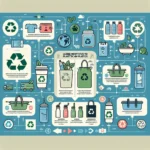The IELTS Reading section tests your ability to comprehend complex texts and answer various question types accurately. Today, we’ll focus on a topic that has become increasingly relevant in recent years: reducing energy consumption at home. This subject has appeared in several past IELTS exams and, given its growing importance in the context of climate change and sustainability, is likely to feature in future tests as well.
Let’s dive into a practice reading passage on this topic, followed by a set of questions that mirror the actual IELTS exam format. This exercise will help you familiarize yourself with the content and question styles you might encounter in the real test.
 Energy-efficient home illustration
Energy-efficient home illustration
Reading Passage
Reducing Energy Consumption in Modern Homes
A) In an era of increasing environmental awareness and rising energy costs, reducing household energy consumption has become a priority for many homeowners. Not only does lowering energy usage benefit the environment by reducing carbon emissions, but it also leads to significant savings on utility bills. Fortunately, there are numerous strategies that households can employ to cut down on their energy consumption without sacrificing comfort or convenience.
B) One of the most effective ways to reduce energy consumption is to improve home insulation. Proper insulation helps maintain a consistent indoor temperature, reducing the need for heating in winter and cooling in summer. This can be achieved by adding insulation to walls, attics, and floors, as well as sealing any air leaks around windows and doors. While the initial investment may be substantial, the long-term savings on energy bills often justify the cost.
C) Upgrading to energy-efficient appliances is another crucial step in reducing household energy consumption. Modern appliances, particularly those with ENERGY STAR certification, consume significantly less electricity than older models. For instance, an ENERGY STAR certified refrigerator uses about 15% less energy than non-certified models, while an efficient washing machine can use 25% less energy and 33% less water than conventional ones.
D) Lighting is another area where substantial energy savings can be achieved. Replacing traditional incandescent bulbs with LED or CFL (Compact Fluorescent Lamp) alternatives can reduce energy consumption for lighting by up to 75%. Moreover, smart lighting systems that automatically turn off lights in unoccupied rooms or adjust brightness based on natural light levels can further optimize energy usage.
E) The adoption of smart home technology can play a significant role in reducing energy consumption. Smart thermostats, for example, learn household routines and adjust heating and cooling accordingly, potentially saving up to 15% on heating and cooling costs. Similarly, smart power strips can eliminate “phantom” energy usage by completely shutting off power to devices when they’re not in use.
F) Behavioral changes can also contribute significantly to energy savings. Simple habits like turning off lights when leaving a room, unplugging electronics when not in use, and using natural light whenever possible can lead to noticeable reductions in energy consumption. Additionally, adjusting thermostat settings by just a few degrees – lower in winter and higher in summer – can result in substantial energy savings without compromising comfort.
G) Harnessing renewable energy sources, particularly solar power, is becoming an increasingly viable option for many homeowners. While the initial installation of solar panels can be costly, they can dramatically reduce or even eliminate electricity bills in the long run. Many governments also offer incentives and tax breaks for solar panel installation, making it a more attractive option for homeowners.
H) Water heating accounts for a significant portion of household energy use. Installing a tankless water heater or a solar water heating system can greatly reduce this energy consumption. Additionally, simple measures like lowering the water heater temperature and insulating hot water pipes can lead to noticeable energy savings.
I) Regular maintenance of home systems and appliances is crucial for maintaining energy efficiency. This includes cleaning or replacing HVAC filters regularly, maintaining heating and cooling systems, and ensuring that appliances are functioning optimally. Well-maintained systems operate more efficiently, consuming less energy and potentially extending the lifespan of the equipment.
J) In conclusion, reducing household energy consumption requires a multifaceted approach, combining technological upgrades, behavioral changes, and regular maintenance. While some strategies may require initial investments, the long-term benefits – both financial and environmental – make these efforts worthwhile. As energy conservation becomes increasingly critical in the face of climate change, adopting these practices not only benefits individual households but also contributes to broader environmental sustainability goals.
Questions
True/False/Not Given
Do the following statements agree with the information given in the Reading Passage? Write
TRUE if the statement agrees with the information
FALSE if the statement contradicts the information
NOT GIVEN if there is no information on this
- Improving home insulation is considered one of the most effective ways to reduce energy consumption.
- ENERGY STAR certified refrigerators use 25% less energy than non-certified models.
- LED bulbs can reduce energy consumption for lighting by up to 75% compared to incandescent bulbs.
- Smart thermostats can save up to 20% on heating and cooling costs.
- Solar panels always provide a return on investment within five years.
Matching Headings
Match the following headings to the correct paragraphs in the passage. Write the correct letter, A-J, next to each heading.
- The role of regular maintenance in energy efficiency
- Harnessing renewable energy sources for homes
- The importance of energy-efficient appliances
- Smart technology’s contribution to energy saving
- The impact of behavioral changes on energy consumption
Multiple Choice
Choose the correct letter, A, B, C, or D.
-
According to the passage, which of the following is NOT mentioned as a benefit of reducing household energy consumption?
A) Lower utility bills
B) Reduced carbon emissions
C) Increased property value
D) Environmental sustainability -
The passage suggests that when it comes to water heating, which of the following is NOT recommended?
A) Installing a tankless water heater
B) Using a solar water heating system
C) Increasing the water heater temperature
D) Insulating hot water pipes -
Which of the following is described as a way to eliminate “phantom” energy usage?
A) Unplugging electronics when not in use
B) Using smart power strips
C) Installing LED lighting
D) Adopting smart home technology
Sentence Completion
Complete the sentences below. Choose NO MORE THAN TWO WORDS from the passage for each answer.
- Proper insulation helps maintain a consistent _____ , reducing the need for heating and cooling.
- Smart lighting systems can adjust brightness based on _____ levels to optimize energy usage.
Answer Key and Explanations
-
TRUE – Paragraph B states, “One of the most effective ways to reduce energy consumption is to improve home insulation.”
-
FALSE – Paragraph C mentions that ENERGY STAR certified refrigerators use about 15% less energy, not 25%.
-
TRUE – Paragraph D states, “Replacing traditional incandescent bulbs with LED or CFL (Compact Fluorescent Lamp) alternatives can reduce energy consumption for lighting by up to 75%.”
-
FALSE – Paragraph E mentions that smart thermostats can save up to 15% on heating and cooling costs, not 20%.
-
NOT GIVEN – The passage does not provide specific information about the return on investment timeline for solar panels.
-
I – Paragraph I discusses the importance of regular maintenance for energy efficiency.
-
G – Paragraph G talks about harnessing renewable energy sources, particularly solar power.
-
C – Paragraph C focuses on the importance of upgrading to energy-efficient appliances.
-
E – Paragraph E discusses how smart home technology contributes to energy saving.
-
F – Paragraph F describes the impact of behavioral changes on energy consumption.
-
C – The passage does not mention increased property value as a benefit of reducing household energy consumption.
-
C – The passage recommends lowering the water heater temperature, not increasing it.
-
B – Paragraph E mentions that smart power strips can eliminate “phantom” energy usage.
-
indoor temperature – From paragraph B: “Proper insulation helps maintain a consistent indoor temperature, reducing the need for heating in winter and cooling in summer.”
-
natural light – From paragraph D: “…smart lighting systems that automatically turn off lights in unoccupied rooms or adjust brightness based on natural light levels can further optimize energy usage.”
Common Mistakes to Avoid
- Misreading or overlooking key information: Pay close attention to specific details and numbers mentioned in the passage.
- Assuming information: Avoid making assumptions based on general knowledge. Stick to the information provided in the text.
- Confusing similar concepts: Be careful to distinguish between related but different ideas, such as energy efficiency and renewable energy.
- Neglecting to read the full passage: Some questions may require information from different parts of the text, so read the entire passage carefully.
Key Vocabulary
- Consumption (noun): The act of using up resources
- Insulation (noun): Material used to insulate something, especially a building
- Efficient (adjective): Achieving maximum productivity with minimum wasted effort or expense
- Phantom energy (noun): Electricity used by electronics when they are turned off but still plugged in
- Thermostat (noun): A device that automatically regulates temperature
- Renewable energy (noun): Energy from a source that is not depleted when used, such as solar or wind power
- Tankless (adjective): Not having or needing a tank (referring to water heaters)
- HVAC (noun): Heating, Ventilation, and Air Conditioning
Grammar Focus
Pay attention to the use of comparative and superlative forms in the passage, such as:
- “Modern appliances, particularly those with ENERGY STAR certification, consume significantly less electricity than older models.”
- “One of the most effective ways to reduce energy consumption is to improve home insulation.”
These structures are commonly used when discussing efficiency and comparing different methods or technologies.
Advice for High Scores in IELTS Reading
- Time management: Allocate your time wisely across all sections of the reading test.
- Skim and scan: Quickly skim the passage for main ideas, then scan for specific details when answering questions.
- Read questions carefully: Ensure you understand what each question is asking before searching for the answer.
- Use context clues: If you encounter unfamiliar vocabulary, try to deduce the meaning from the context.
- Practice regularly: Familiarize yourself with various question types and passages on diverse topics.
- Improve vocabulary: Build your vocabulary, especially in areas related to science, technology, and current affairs.
- Stay calm and focused: Don’t spend too much time on difficult questions; move on and return if time allows.
Remember, success in IELTS Reading comes with consistent practice and a strategic approach. Focus on understanding the passage’s main ideas and supporting details, and always base your answers on the information provided in the text.
For more practice on IELTS Reading and tips on how to create a sustainable home, visit our website. You can also find additional resources on reducing your environmental footprint and explore other ways to reduce energy consumption at home.


